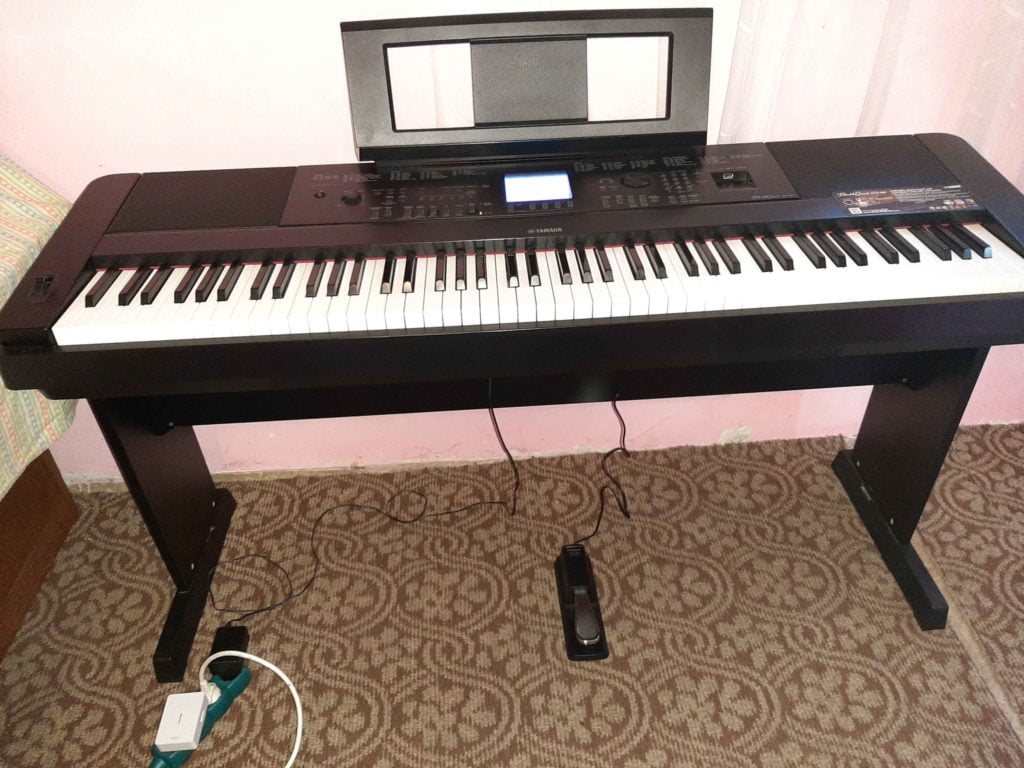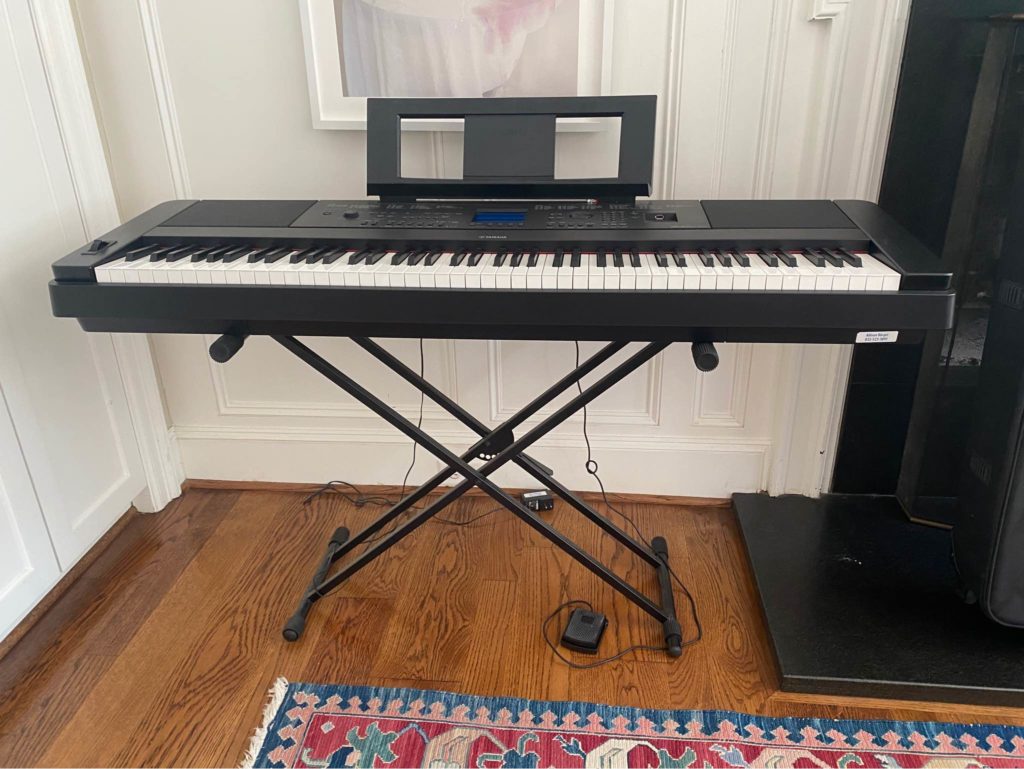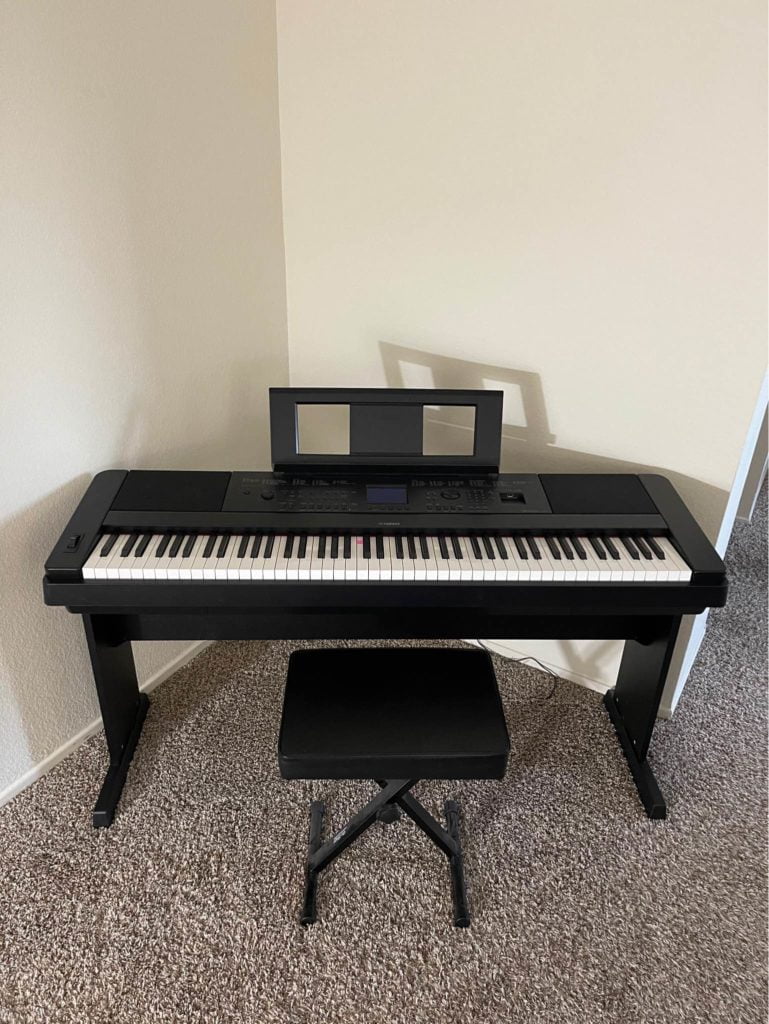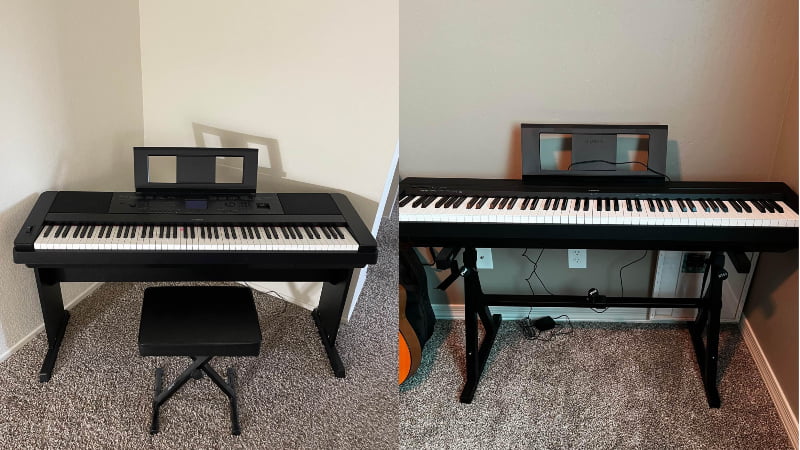The Amazon exclusive Yamaha P71 put up a pretty good fight in this Yamaha P71 vs DGX-660 comparison. But after comparing their features head to head, I found the DGX-660 to be the better option, which is about expected considering its steep price tag.
The Yamaha DGX-660 has an incredibly wide sound library, with Yamaha PureCF Sound Engine voices, drum and SFX packs, and even a Glite pack with over 380 different tones. On top of that, it has great hammer action and a ton of different piano features that make it the clear winner.
With that said, the Yamaha P71 put up a fair fight for a budget-friendly, beginners piano with a decent set of features. It has great piano tones, a couple of effects, and it even has dual and duo mode for added versatility. While this piano isn’t as good as the DGX-660, it’s a great option for any beginner to novice pianist out there.
Yamaha P71 vs DGX-660: Comparison Chart




Last update on 2025-06-28 / Affiliate links / Images from Amazon Product Advertising API
Yamaha P71 vs DGX-660: Differences
To find out the better option between the two, I decided to test out their features and compare them with each other. And by the end of the comparison, the Yamaha DGX-660 beat out the Yamaha P71 by 4-1, which isn’t a surprise, considering the P71 is an entry-level option and the DGX-660 is a premium model. On the DGX-660, you get better voices, a wider sound library, and an array of playing modes and effects that make it the better overall instrument.
Feel
The winner: Yamaha DGX-660
The Yamaha DGX-660 has a flat out better feel than the Yamaha P71. The DGX-660 feels very close to an acoustic piano while the Yamaha P71 is lacking in some areas. However, the Yamaha P71 put up a pretty good fight as the progressive hammer action does give a realistic weight.

Hammer Action
The Yamaha DGX-660 is equipped with the Yamaha Graded Hammer System (GHS). This is a system designed to properly mimic the feel of an acoustic piano. When you play the DGX-660, you’ll probably notice that the keys on the left side of the piano are significantly heavier than the right side. This is intentional as it’s similar to how the weight is distributed on an acoustic or grand piano.
The Yamaha P71 has a similar hammer action, but it doesn’t use GHS. Instead, it uses a more generic hammer action system. With that said, the Yamaha P71 still has progressive hammer action that mimics an acoustic piano very well, just not as good as the DGX-660.
Key Texture
While the DGX-660 has better hammer action than the P71, both pianos have pretty disappointing keys. While they have full, 88-key keyboards, the keys are made of plastic and don’t have any coating on them to mimic ebony and ivory keys you’ll find on acoustic instruments.
The key texture is a common complaint that many people have about both pianos, and it’s a slight letdown that the DGX-660 doesn’t have wooden or textured keys considering its price.
Tone
The winner: Yamaha DGX-660
In terms of tone, the Yamaha DGX-660 is a clear winner. This is because it has a better tone generation system and sound library. If you’re a novice or professional pianist looking for an instrument for your performances, the DGX-660 beats out the Yamaha P71’s tone and sound library by miles.
Tone Generation
The Yamaha DGX-660 uses the PureCF Sound Engine for its piano tones. This is a Yamaha innovation where real piano sounds are recorded from the Yamaha CFIII Concert Grand Piano, which is known for its bright and crisp tone. The samples are recorded fully, with natural decay and a digital filter is added on top to create more realistic stereo sounds. On top of that, it also has Glite sounds and SFX voices, but more on that later.
The Yamaha P71 uses a simpler AWM system. AWM stands for “Advanced Wave Memory”, this is a Yamaha innovation that puts a modern twist on the standard sampling method. It still records samples from real Yamaha pianos with natural decay, however, the tones don’t come out as crisp or bright as the Yamaha DGX-660. With that said, the Yamaha P71 has some of the most realistic piano tones in its price range, which is why it’s such a popular beginners piano, it just isn’t as good as what you’ll find on the DGX-660.
Sound Library

When it comes to the sound library, the Yamaha P71 doesn’t put up much of a fight. The Yamaha P71 has 10 different voices. These include a couple of piano, electric piano, bass, synth, and string voices. For beginners, this is more than enough for most songs and genres, and also allows you to experiment with a wide array of sounds. For most digital pianos, 10 voices is actually a lot, however, it doesn’t compare to what the Yamaha DGX-660 has to offer.
The DGX-660 comes with over 400 different voices from different sound engines. The PureCF Sound Engine offers a wide range of different piano tones. On top of that, it comes with 150 piano, electric piano, synth, and bass voices. But it doesn’t end there as it’s also equipped with different drums, SFX, and a 388-voice Glite pack.
The Yamaha DGX-660 offers more voices than most people will need, especially when starting their piano journey. However, as you get better and start performing in different venues, the wide range of voices allows for a whole lot of versatility.
Piano Features
The winner: Yamaha DGX-660
Both of these pianos come with a fair amount of different piano features. The Yamaha P71 actually comes with more than enough features for a beginner, which is why it’s a great option for a first piano. However, as the premium option, the Yamaha DGX-660 comes with tons of different features that you can use in performing, recording, and rehearsing.
Playing Modes
One pleasant surprise I found with the Yamaha P71 is the different playing modes. This piano comes with dual mode and duo mode, two key features of any digital piano. Dual mode allows you to blend two different voices and play them at the same time. The result is a unique tone that you won’t find on most regular pianos. On top of that, the duo mode splits the piano into two tiny “twin” pianos. That way, students and teachers can play together without having to cross over to other sides of the instrument. This mode also allows you to play beautiful piano duets with other musicians.
The Yamaha DGX-660 also comes with all the features we mentioned above. However, the difference is that it also comes with split mode and the Yamaha Educational Suite (Y.E.S.). With split mode, you can load one voice to each side of the piano. For example, you can load a bass tone on the left side and a piano tone on the right side, giving the illusion that you’re playing two instruments.
The Y.E.S. program isn’t something most pianists will use often. However, it offers a unique way for people to learn the basics of piano which is still a neat feature to have.
Effects

Most entry level pianos for beginners don’t come with effects, which is what makes the Yamaha P71 special. While it’s a basic entry-level digital piano, it comes with four different types of reverb. You can use this to add a lot of body and realism to the piano tones, and can also be used to add depth to your sound. This is a very useful effect and one of the first effects a pianist should learn how to use.
While the Yamaha P71 offers reverb effects, the DGX-660 takes it to another level. On top of reverb, the DGX-660 comes with chorus, IAC, and a master EQ. These are fairly advanced effects that pianists can use to take full control over their tone. This definitely beats out the Yamaha P71 and allows the DGX-660 to become a truly professional instrument ready for performing and recording.
Polyphony
The Yamaha P71 has 64-note maximum polyphony. For a lot of basic music pieces, this is more than enough. In fact, 64-note polyphony is decent enough for most piano music. However, if you plan to play multiple wide chords with the sustain pedal on, you might run into some trouble with 64-note polyphony.
The Yamaha DGX-660 comes with 192-note maximum polyphony. This is more than enough to handle wide chords and complex piano music. In terms of digital pianos, the polyphony on the DGX-660 is very good and can play just about any form of music out there.
Sound System
The winner: Tie
It may come as a surprise, but these two options come with the same sound system. Both of them are equipped with two 6-watt speakers that are great for rehearsing alone. However, if you’re playing with a band and other musicians, it may not be loud enough and you might need to plug into an external amplifier or sound system.
Both of the pianos offer ways to plug in to an external sound system, which is great for when you really need to be heard. Since the Yamaha DGX-660 is more expensive than the P71, it might have been nice if they added better and louder speakers. However, the speakers are fairly high-quality and still produce a beautiful and accurate sound.
Yamaha P71 vs DGX-660: The Similarities
Since they come from the same brand, the Yamaha P71 and the DGX-660 share some similarities. While they aren’t from the same product line, they are both portable digital pianos that are relatively easy to bring around to gigs and other musical events. However, the DGX-660 is a bit heavier, which is important to remember.
On top of that, they are both full 88-key keyboards with some sort of progressive hammer action. While they use different hammer action systems, they are used to accomplish the same goals, which is to replicate the feel of an acoustic piano. Another similarity between these two are their lackluster keys. The keys are made of plastic with no additional coating whatsoever, which can be a huge flaw for most experienced pianists.
Quick Rundown of the Yamaha DGX-660
- The Pure CF Sound Engine faithfully reproduces the tone of a meticulously sampled and highly acclaimed Yamaha concert grand piano
- GHS weighted action is heavier in the low register and lighter in the high, just like an acoustic piano
- Score display puts music notation of MIDI songs on the screen, helping you play your favorites by following the bouncing ball
- The Piano room lets you choose from a variety of pianos and acoustic settings to create your own personal piano environment
- The 6 track recorder allows you to capture your performances and song ideas, then add additional layers to spice up your pieces
Last update on 2025-06-28 / Affiliate links / Images from Amazon Product Advertising API
Quick Rundown of the Yamaha P71
- Acoustic Piano Feel - Touch-sensitive keys allow for true expression and dynamic performance. The weighted action replicates the acoustic piano experience
- Elevated Sound - Choose from 10 unique Voices, including the richness and resonance of a Yamaha grand piano, with full dynamic sound and deep bass
- Effortless Control - Simple one-button operation and streamlined functionality designed to keep you focused on your music
- Layered Sound - Dual Mode lets you blend two Voices, like piano and strings, creating a rich, layered sound for an inspiring new playing experience
- Included sustain pedal allows for subtle variations and greater expression in your performances
Last update on 2025-06-28 / Affiliate links / Images from Amazon Product Advertising API
Product Video
Related Articles to Yamaha Dgx 660
- Yamaha YDP-164 vs DGX-660: Why You Should Go for the DGX-660
- Yamaha DGX-660 vs Roland FP-90: Why the Roland FP-90 Is the Better Pick
- Yamaha DGX-530 vs 660: Why the DGX-660 Is the Better Pick
- Yamaha DGX-505 vs 660: Why the DGX-660 Is the Better Pick
- Yamaha DGX-660 vs DGX-640: A DGX Comparison
- Yamaha DGX-660 vs DGX-630: A DGX Comparison
- Yamaha DGX-620 vs 660: Finding the Best DGX Model
- Yamaha DGX-660 vs YDP-163: Which Is the Better Piano?
- Yamaha DGX-660 vs Roland Juno DS-88: Which Is the Better Piano?
- Yamaha DGX-660 vs Casio PX-360: Which Is the Better Piano?
- Yamaha DGX-660 vs YDP-144: Which Is the Better Yamaha Piano?
- Yamaha DGX-660 vs Korg Havian 30: Which Is the Better Digital Piano?
- Yamaha DGX-660 vs Casio CGP-700: Which Is the Better Pick?
- Yamaha DGX-660 vs YPG-535: Finding the Best Yamaha Digital Piano
- Yamaha DGX-660 vs P515: Is the P515 Worth the Extra Cost?
- Yamaha DGX-660 vs P-115: Which Yamaha Model Is Better?
- Yamaha DGX-660 vs Casio PX-560: Which Piano Offers More Value For The Money
- Yamaha DGX-660 vs 650: A DGX Comparison
- Korg XE-20 vs Yamaha DGX-660: Finding the Best Digital Piano
- Yamaha P45 Vs DGX-660: A Head-to-Head Comparison
- Yamaha DGX 670 Vs 660: The Distinct Difference In Details You Need To Know About
- Yamaha YDP-103 Vs DGX-660: Which Is The Better Yamaha Piano?
- Casio PX-770 Vs Yamaha DGX-660: Should You Get A Portable Or Console Digital Piano?
- Yamaha P125 vs DGX 660 Comparison: Can the P125 Hold Its Own Against the DGX 660?
Related Articles to Yamaha P71
- Alesis Virtue Vs Yamaha P71: Can The Alesis Console Piano Beat Out The Amazon Exclusive?
- Yamaha P71 vs P95: Which Is The Better Digital Piano?
- Yamaha P71 vs Korg B2 Comparison: Battle Of the Two Top Beginner Pianos On the Market
- Yamaha P71 vs Casio CDP-S150: Which Is the Best Beginner Piano On the Market?
- Yamaha P71 vs Donner DEP-20: Which Is the Best Beginner Piano?
- Yamaha P71 vs Casio PX-160 Comparison: Battle of the Two Best Digital Pianos on a Budget
- Yamaha P71 vs Alesis Recital: Why the Amazon Exclusive P71 Is the Best Option for Beginners
- Yamaha P71 vs Roland FP10 Review: A Tight-Knit Battle Where The FP10 Comes Out On Top
- Yamaha P71 vs Alesis Recital Pro: Which Digital Piano is the Best Option for Beginners?
- Yamaha P71 vs P125: Why the Yamaha P125 Is the Better Investment
- Yamaha P71 vs P45: Why the Amazon Exclusive P71 is the Better Digital Piano
References:
- DGX-660: https://usa.yamaha.com/products/musical_instruments/pianos/p_series/dgx-660/specs.html#product-tabs
Lulacruza is an electronic folk duo operating at the junction of the hypermodern and the ancient. Our music weaves together hypnotic female singing, South American folk instruments and electronic processing, while channeling pulsating waves from the source of creation.
Lalucruza is also a community where you can connect with other music lovers to collaborate, exchange ideas and share knowledge. A platform for who wants to learns the basics of playing piano, guitar, drum masters’ technique, etc.. is the premise of our website.
